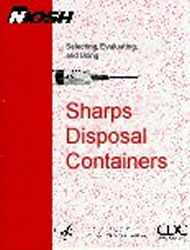Selecting, Evaluating and Using Sharps Disposal Containers
January 1998
DHHS (NIOSH) Publication Number 97-111

The Occupational Safety and Health Act of 1970 created the National Institute for Occupational Safety and Health (NIOSH). NIOSH is charged with identifying the causes of work-related diseases and injuries, evaluating the hazards of new technologies and work practices, creating ways to control hazards, and recommending occupational safety and health standards.
Occupational exposure to bloodborne pathogens (including the hepatitis B and C viruses [HBV and HCV] and the human immunodeficiency virus [HIV]) poses a significant risk to workers in the healthcare industry and related occupations. The primary route of exposure to bloodborne pathogens is accidental percutaneous injury caused by needlesticks (puncturing of the skin by a needle or similar sharp object). In the United States, approximately 800,000 needlestick injuries occur in hospitals annually—an average of one injury every 10 seconds. Studies have shown that many of these injuries occur after a sharp (needle or other sharp object) is used; as many as one-third of all sharps injuries have been reported to have occurred during disposal activities.
